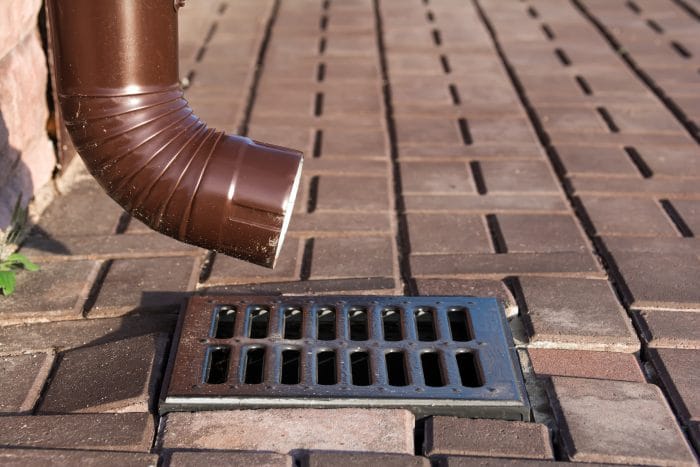
Helping St. Louis Homeowners Clean Out Downspout Drains since 1985
If there’s one thing that we know to be true about St. Louis, it’s that the weather is anyone’s guess. Forget “in like a lion, out like a lamb!” Our Spring rainy season lasts a lot longer than average. According to weatherspark.com, the wet season in the Show Me state lasts a little over five months, starting in late March and running through the end of August. On any given day during this time frame, there’s a nearly 30% chance of rain. The wettest month in the Lou is May, averaging over 12 days of rain.
This is why St. Louis homes have gutter systems! Rain gutters move water away from your home. Without them, water can sit on your roof – along with leaves, dirt, and debris, causing damage to your roof, and to your home.
How Do Rain Gutters Work?
Gutters sit just under the edge of your roofline, ready to catch any rainwater as it hits your roof. The gutters carry water to the corners of your roof, where vertical sections, called downspouts, are located. Gutters also collect leaves, twigs, dirt, and debris from your roof. If they’re not cleaned out, they can’t do the important work of moving water away from your home.
Downspouts keep water from seeping into your foundation and even flooding your basement. If you grew up in St. Louis or have lived here for a number of years, chances are pretty good that you’ve dealt with a flooded basement. It’s an expensive mess to clean up and not something you want to go through more than once if you can help it!
DIY Gutter Cleaning
Clearing your home’s gutters, will help to keep them working efficiently and effectively. Depending on when you clean them, it can be a messy job. If you’re not comfortable climbing and spending time on a ladder, it’s best to call in a professional for help.
There are just a few simple gutter cleaning tools you’ll need, and you likely already have them at home:
- Garden hose
- Gloves
- Extension ladder
- Gutter scoop
- Large trash bags or tarp
Starting at one corner of your home, place a large tarp or several drop cloths on the ground under the gutter. Standing on an extension ladder, reach into the gutter, scoop out leaves, dirt, and other debris as you go, and drop it onto the tarp.
If you notice standing water in your gutters, you may need to adjust the slope, so they’ll properly drain toward the downspouts. And if there’s standing water at the bottom, consider adding downspout extensions to carry the water farther away from your home’s foundation.
While on the extension ladder, be extremely careful not to stretch too far. You’ll need to move the ladder frequently so that you don’t lean over and tip your ladder. Ideally, you’ll move the tarp each time you move the ladder. This method can get messy, as some of the contents you drop won’t land on the tarp, so you’ll need to do some additional yard and landscape clean up. Once the tarp is full, dump it into a trash bag and start again, continuing around your home until all of the gutters are free of debris.
If your gutters are completely dry, you can use a leaf blower to remove the bulk of dried leaves, small twigs and dirt from your gutters. Just be prepared to do some leaf blowing or raking around your landscaping! If the leaves and debris are wet, you’ll need to use a small scoop or wear gloves to remove the gunk. You might also be able to use a pressure washer. You may hear or see water run into your downspouts as you remove the gutter debris. If you know water is moving into the downspout, but not coming out, you probably have a clogged downspout.
DIY Gutter Downspout Cleaning
Once you’ve finished with the gutter cleaning, you’re ready to move to the gutter downspouts. First, look to see if your downspouts have horizontal extensions. You’ll want to remove these before you begin cleaning.
Next, place your ladder next to the first downspout, in a sturdy, even location. Bring a garden hose up the ladder with you and place it into the top of the downspout where the gutter meets it. Ideally, you’ll have someone on the ground who can turn on the water for you and watch to see if it’s flowing correctly out the bottom of the downspout.
If it’s not, you’ve got a buildup in your downspout. Greater water pressure can help break up the clog and push out any debris stuck inside. To get stronger pressure, try wrapping an old towel around the garden hose to block any air from the opening of the downspout. Then have someone on the ground turn the hose on at full blast. If that doesn’t do the trick, it’s time for Plan B.
Plan B
Remove the garden hose and feed an auger or plumbing snake into your downspout. You should be able to feel when it hits the blockage – which is typically where the pipe curves near the bottom. If you can’t reach it from the top, feed the snake up through the bottom. Remove the gunk and debris and test the flow again by running water from your hose into the downspout. If you removed any horizontal extension pipes before you began, now is the time to check each of those for clogs and clear them out before reinserting them into the drainpipe.
Final Rinse
Your last step after after gutter and downspout cleaning is to flush the entire system. Place your garden hoseinto the gutter at the farthest point from the opening of the downspout and turn on the water. Leave it on until the water flowing out of your downspouts is clear of all dirt and debris.
Gutter Guards
If cleaning gutters and downspouts isn’t your type of work, there are ways to make the task easier! Gutter guards protect your gutter system from gathering leaves, twigs and other debris that can block your gutters and prevent water from flowing correctly down and away from your home’s foundation. There are a few types available. Some, like mesh screen and foam inserts can be easily installed by homeowners. These solutions act as a strainer, filtering water and catching gutter debris. These solutions come in sections that slide or pop into place.
More advanced systems, like micro-mesh screens and covers typically need to be installed by professionals. LeafGuard and MasterShield are two brands that offer these types of systems. If you’re interested in this type of system, HomeAdvisor can help you find the right solution for your home.
If you don’t want to clean your gutters and downspouts but aren’t ready to make an investment in gutter guards, consider hiring a professional gutter cleaning service, like Maplewood Plumbing to handle our gutter cleaning and gutter maintenance for you.
Maplewood Plumbing and Sewer has been cleaning clogged gutters and downspouts for St. Louis city homeowners for more than 40 years. Our family-owned business prides itself on our solid reputation as a gutter cleaning service provider in the community. Give us a call at 314-645-6350 and see for yourself why our loyal customers won’t use anyone else!
We offer a one-year warranty on all parts and labor excluding washers.
We are also experts in kitchen plumbing, basement plumbing, bathroom plumbing, and tankless water heater installation.
Give us a call or fill out the contact form here to request a bid.


